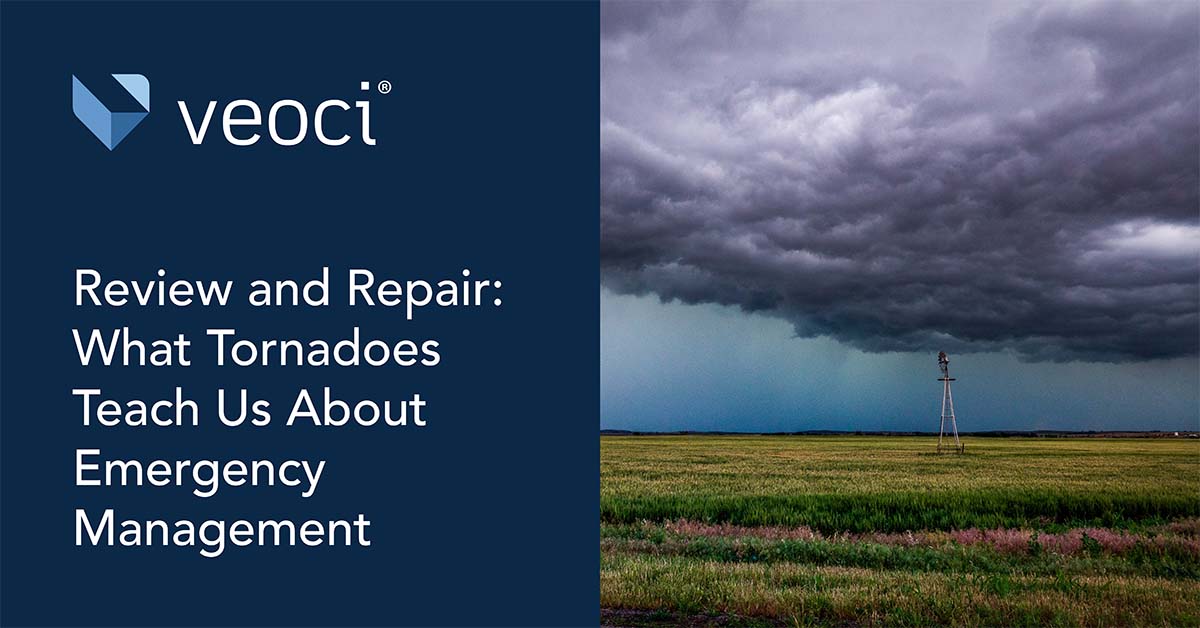Spring is the bridge between winter and summer, and it lets the other two seasons’ weather patterns collide. The collision of cold and warm air gives rise to tornadoes and these conditions put many communities and towns across the U.S. on alert.
March officially kicks off tornado season in the U.S. Though tornado-friendly atmospheric conditions and the corresponding twisters are most common through the spring months, storms also brew towards the end of the year in the U.S. South, giving communities in this region more reason to keep an eye on the skies.
These communities prepare for these serious storms in a number of ways. The general principles that go into these communities’ planning efforts are good lessons in preparedness and emergency management as well.
Tornado Preparedness and Emergency Management
Like many natural disasters and weather events, tornadoes force the communities they habitually hit to prepare for sudden dangerous conditions, with multiple response plans, notification pathways for citizens, and quick thinking. Communities hit by tornadoes must also be ready to rebuild and create stronger infrastructure, while applying what they learned to be better prepared for the next disaster.
With tornado season fast approaching, what are some lessons we can learn from these communities to make all emergency management more efficient and effective?â€
1. Communication redundancies.
When a tornado watch or warning is in effect, citizens usually turn to multiple channels to stay up on the situation. Towns can’t rely on everyone having the same access and open channels however, but still need to get word out. Tornado sirens fill this gap with a very clear “get ready” message. Communication redundancies are an essential part of tornado preparedness and response.
In emergency management, alternate modes of communication are extremely important for keeping response stakeholders updated and citizens safe. Backup communications plans as laid out in EOPs help ensure everyone stays on the same page, especially when the situation renders workspaces and devices inaccessible.
Digital platforms often pick up this slack. Not only can platforms reach stakeholders on their devices, they can serve as alternate communications channels should conventional means be unavailable. Veoci, for example, can provide multiple streams of communication that are accessible from anywhere, striking down limitations that materialize during emergencies.â€
2. Don’t rely on just one person.
Although many communities have emergency alert processes in place, citizens can learn to read the warning signs in the weather and identify the conditions typical of tornado watches. It is always better to have multiple people aware of a potentially dangerous situation.
Emergency management programs need succession plans in place to ensure that one person’s absence doesn’t break your incident response plans. Virtual platforms can store plans and identify succession, so during those chaotic moments, it is clear to everyone who is in charge of what steps in your response.
3. Review and learn from mistakes.
You can’t prepare for everything, but you can always learn from the past. Tornadoes happen suddenly and there’s little anyone can do to stop these storms. Following a tornado, a community’s focus should shift to recovery, review, and mitigation. Mistakes in a response can be used to improve planning for future tornadoes.
After events occur, after-action reports and reviews help emergency managers and their EOCs build stronger programs. Mistakes and oversights, while initially detrimental, do have some value. Lessons learned can be worked back into plans and help build more comprehensive EOPs. Again, virtual platforms are an excellent way to coordinate the analysis and input needed for this type of revision, and pull data from the incident in for review.â€
4. Programs, partners, and exercises.
For local governments in tornado prone areas, there are different programs in place, including Storm Ready on a national level, that exist for the purpose of preparing and testing tornado response systems. In general emergency management, there are always tabletop and national level exercises your organization can participate in to prepare for an incident. Participating in these programs, and finding platforms that facilitate them, allows you to test your plans without having to deal with the fallout of an actual crisis.â€
5. Invest now.
Individuals living in tornado zones do not wait until their homes or possessions are affected by a tornado to take protective measures. Renters, home, business, and flood insurance policies all help individuals cut down the costs of recovering from storms.
Likewise, emergency managers should invest in their emergency management programs and EOCs continually. Securing buy-in from leadership and committee can make procuring funds for improvements difficult. But this shouldn’t stop EOC managers from trying. Early investment pays off during emergencies, and demonstrating this truth may help funnel the funds an EOC needs into its wallet.
Holistic Preparedness and Better Outcomes
When it comes to tornados, communities need to be holistic in their preparedness, from planning, to response, to mitigation. General emergency management is no different. It’s crucial that programs invest in every step of planning and response and keep stakeholders from having to play catch-up when an incident occurs. Virtual platforms like Veoci can be an asset in keeping EOCs ready for these incidents and implementing the takeaways of tornado response across U.S. communities.








